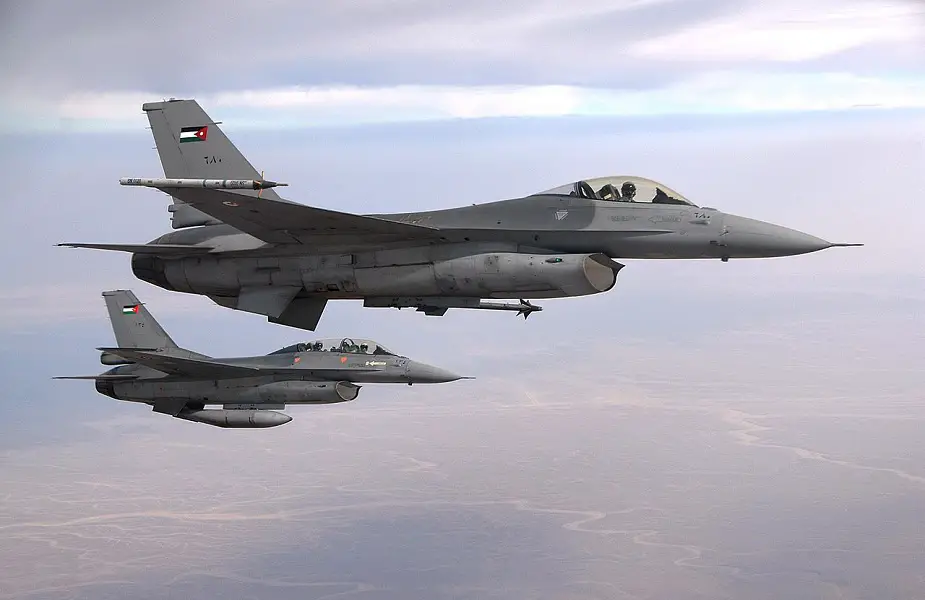The US State Department has made a determination approving a possible Foreign Military Sale to the Government of Jordan of F-16 C/D Block 70 Aircraft and related equipment for an estimated cost of $4.21 billion
Follow Air Recognition on Google News at this link
 Royal Jordanian Air Force F-16 Fighting Falcon aircraft (Picture source: US Air Force)
Royal Jordanian Air Force F-16 Fighting Falcon aircraft (Picture source: US Air Force)
The Government of Jordan has requested to buy twelve (12) F-16 C Block 70 aircraft; four (4) F-16 D Block 70 aircraft; twenty-one (21) F100-GE-129D engines or F100-PW229EEP engines (16 installed, 5 spares); twenty-one (21) Improved Programmable Display Generators (iPDG) (16 installed, 5 spares); twenty-one (21) AN/APG-83 Active Electronically Scanned Array (AESA) Scalable Agile Beam Radars (SABR) (16 installed, 5 spares); twenty-one (21) Modular Mission Computers (MMC) 7000AH (16 installed, 5 spares); twenty-seven (27) LN-260 (or equivalent) Embedded Global Positioning System (GPS) Inertial Navigation Systems (INS) (EGI) with Selective Availability Anti-Spoofing Module (SAASM) and Precise Positioning Service (PPS) (16 installed, 11 spares); six (6) AN/AAQ-33 Sniper Advanced Targeting Pods (ATP); thirty-one (31) Link 16 Low-Volume Terminals (for aircraft and ground stations) (26 installed, 5 spares); seventy-two (72) LAU-129 launchers (64 installed, 8 spares); twenty-one (21) M61A1 Vulcan cannons (16 installed, 5 spares); four hundred two (402) FMU-139 or FMU-152 Joint Programmable fuzes; one hundred (100) KMU-556 Joint Direct Attack Munition (JDAM) tail kits for 2,000LB GBU-31; one hundred two (102) KMU-572 JDAM tail kits for 500LB Laser JDAM GBU-54; one hundred (100) MAU-209 Computer Control Group (CCG) for Paveway II (PWII) GBU-10; one hundred two (102) MXU-651 Air Foil Group (AFG) for 2,000LB PWII GBU-10; one hundred (100) MAU-210 Enhanced Computer Control Group (ECCG) for 500LB Enhanced Paveway II (EP II) EGBU-49; one hundred three (103) MXU-650 Air Foil Group (AFG) for 500LB EP II EGBU-49; two hundred (200) MK-84 or BLU-117 (or equivalent) bomb bodies; two hundred four (204) MK-82 or BLU-111 (or equivalent) bomb bodies; six (6) MK-82 inert bombs; and two (2) MAU-169 Computer Control Group (CCG) trainers. Also included are AN/ARC-238 radios; AN/APX-126 or equivalent Advanced Identification Friend or Foes (AIFF) with Combined Interrogator Transponder (CIT); Joint Helmet Mounted Cueing System II (JHMCS II) or Scorpion Hybrid Optical-based Inertial Tracker (HObIT) helmet mounted displays; AN/ALQ-254 Viper Shield or equivalent Integrated Electronic Warfare (EW) systems; AN/ALE-47 Countermeasure Dispenser Systems (CMDS); KY-58M Cryptographic Devices; KIV-78 Cryptographic Devices; Simple Key Loaders (SKLs); Joint Mission Planning System (JMPS) or equivalent; PGU-28 High Explosive Incendiary (HEI) ammunition; PGU-27 training ammunition (non-HEI); ARD-446 impulse cartridges; ARD-863 impulse cartridges; BBU-36 impulse cartridges; BBU-35 impulse cartridges; MK-124 smoke flares; MJU-7/B flare cartridges L463 or MJU-53 or equivalent; Common Munitions Built-in-Test (BIT) Reprogramming Equipment (CMBRE); ADU-891 adapters for CMBRE; DSU-38 laser sensors for Laser JDAM GBU-54; Cartridge Actuated Device/Propellant Actuated Devices (CAD/PAD); BRU‐57 bomb racks; MAU‐12 bomb racks and TER‐9A triple ejection racks; other chaff and flare, ammunition, and pylons; launcher adaptors and weapons interfaces; fuel tanks and attached hardware; travel pods; aircraft and weapons integration, test, and support equipment; electronic warfare database and mission data file development; precision measurement and calibration laboratory equipment; secure communications; cryptographic equipment; precision navigation equipment; aircraft and personnel support and test equipment; spare and repair parts; repair and return services; maps, publications, and technical documentation; studies and surveys; classified/unclassified software and software support; personnel training and training equipment; facilities and facility management, design and/or construction services; U.S. Government and contractor engineering, technical and logistics support services; and other related elements of logistical and program support. The estimated total cost is $4.21 billion.
This proposed sale will support the foreign policy and national security objectives of the United States by helping to improve the security of a Major Non-NATO Ally that is an important force for political stability and economic progress in the Middle East.
The proposed sale will improve Jordan’s capability to meet current and future threats by ensuring continued interoperability with U.S. and coalition forces. These aircraft will modernize the Jordanian fighter aircraft fleet and support operational requirements associated with regional U.S.-coalition goals, such as countering violent extremist organizations, countering malign state and non-state actors, and border defense. Jordan will have no difficulty absorbing this equipment into its armed forces.
















